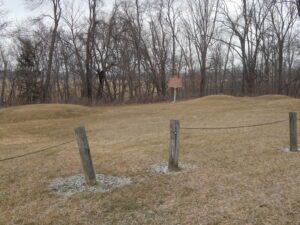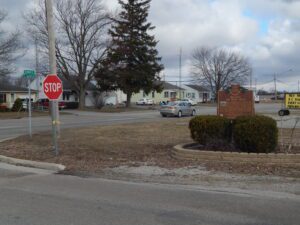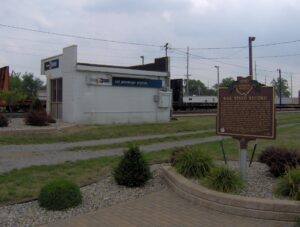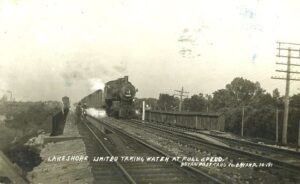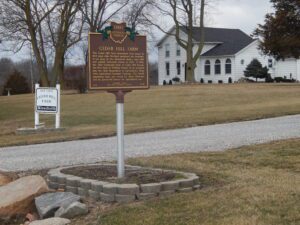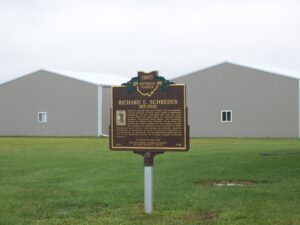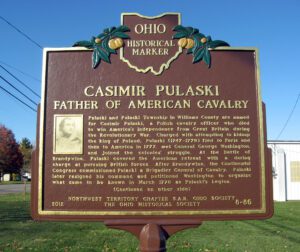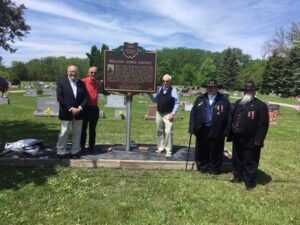, OH
The Nettle Lake Mound Group consists of 4 low mounds overlooking a stream that runs into Nettle Lake. The mounds vary in height from 1 to 3 feet and in diameter from 18 to 30 feet. The mounds are composed primarily of reddish-brown sand (secondary mound) covering a layer of darker sand and loam (primary mound). These mounds have been partially excavated in the past by pot hunters in search of relics. Although the records of these excavations are vague and incomplete, pottery fragments, burials, and flint artifacts found in the mounds indicate that they were constructed by the Hopewell Indians.
, OH
Here, on September 6, 1918, Bryan’s Air Mail Field began operations as one of Ohio’s first official airfields with the arrival of a survey flight to establish air mail service between New York and Chicago. Scheduled service began on July 1, 1919, and stretched west to San Francisco on September 8, 1920, completing the 2,666 mile U.S transcontinental air mail route. Flying the Curtiss JN-4H “Jenny,” R-4, Standard JR-1B, and later, the De Havilland DH-4, aviators pioneered cross continental flight in open cockpit biplanes without radios or electronic navigational aids and reduced coast to coast mail delivery from 87 hours by rail to 33 hours by air.
, OH
In 1966 the New York Central Railroad Company (A.E. Perlman, President) proposed a test of existing rail passenger equipment to determine the feasibility of operating high-speed passenger service between cities up to 300 miles apart. The site chosen for the test was near Bryan, Ohio on the longest multiple track straight railroad line in the world. This sixty-seven mile straight trackage from Toledo, Ohio to Butler, Indiana was originally constructed by the Northern Indiana Railroad Company of Ohio incorporated March 3, 1851. On July 23, 1966 the New York Central Technical Research Department ran their Budd RDC-3 passenger car number M-497 fully instrumented for stress analysis, and propelled by two roof-mounted jet aircraft engines. The speed of 183.85 miles per hour was attained, the highest recorded on a railroad in North America at that time and to this day.
, OH
Like many nineteenth century communities in Ohio, Stryker owes its birth and early growth to the railroad industry. Stryker, named for Rome, New York, attorney and railroad executive John Stryker, was surveyed on September 19, 1853, beside the proposed Northern Indiana Railroad. For more than fifty years, “track pans” at Stryker allowed steam locomotives to take on 5,000 gallons of water while traveling at forty to fifty miles per hour, saving valuable time, “the principal enemy of railroad schedules.” On July 23, 1966, the U.S. rail speed record of 183.85 miles per hour was set through Williams County, including through Stryker. The Stryker depot was constructed in 1900 and placed on the National Register of Historic Places on August 7, 1989. (continued on other side)
, OH
The Cedar Hill Farm Homestead story began in 1864 when John Burchard purchased the farmland. It has been in the Kisseberth family since 1903 and gained centennial status in 2003. In 2008, the Ohio Centennial Farm of Cedar Hill became the first farm in Williams County to be accepted into the Ohio Department of Agriculture’s Clean Ohio Agricultural Easement Program. The fourth generation farm now owned by Jason Allomong, will be preserved forever for agricultural use.
, OH
Richard E. Schreder grew up in Toledo, Ohio and graduated from the University of Toledo with a degree in Mechanical Engineering. He was a decorated navy pilot and iconic aviation figure who helped shape the American soaring movement, international glider design, and competitive soaring and piloting flight strategies. He also made high performance gliders available to a wide audience through the affordable kit production of his distinctive HP (High Performance) glider designs. These designs and Schreder’s numerous contributions to aviation and the sport of soaring are recognized as “groundbreaking and pioneering” by the Smithsonian Museum and are part of the Smithsonian National Air & Space Museum’s permanent collection. (continued on other side)
, OH
Pulaski and Pulaski Township in Williams County are named for Casimir Pulaski, a Polish cavalry officer who died to win America’s independence from Great Britain during the Revolutionary War. Charged with attempting to kidnap the king of Poland, Pulaski (1747-1779) fled to Paris and then to America in 1777, met General George Washington, and joined the colonies’ struggle. At the Battle of Brandywine, Pulaski covered the American retreat with a daring charge at pursuing British forces. After Brandywine, the Continental Congress commissioned Pulaski a Brigadier General of Cavalry. Pulaski later resigned his command and petitioned Washington to organize what came to be known in March 1778 as Pulaski’s Legion.
, OH
William J. Knight (1837-1916) was born in Wayne County, Ohio and raised by his grandparents, Jacob and Martha Knight, near Farmer, Ohio. After the outbreak of the Civil War, William enlisted in Company E, 21st Ohio Volunteer Infantry. On April 12, 1862, the twenty-five year-old Knight participated in “Andrews Raid” as an engineer. Led by James J. Andrews, the raiders stole the locomotive “General” at Big Shanty, Georgia, planning to cut telegraph lines and destroy railroad bridges and tracks as they headed north between Atlanta and Chattanooga. Above Ringgold, Georgia, the raiders were captured. Eight were executed. Knight and seven others escaped from an Atlanta jail on October 16, 1862 and made it to Federal lines. Six raiders were exchanged in 1863 (Continued on other side)


